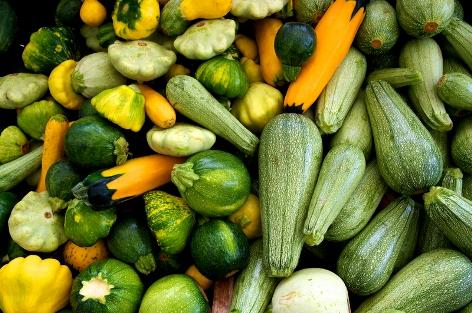Zucchini is an excellent alternative to spaghetti noodles and has become a staple in low-carb diets. Additionally, squash is also a tasty side complement to any dish. While both fruits are excellent sources of nutrients and can be pretty versatile, some may still wonder what is the real difference between zucchini and squash.
While walking through the produce aisle of any grocery store, you will see many fruit and vegetable options. These choices will change depending on the seasons; however, many vegetables and fruits may appear similar at first glance. Yet, there is a difference between squash and zucchini. For starters, squash is an all-encompassing term describing several fruit plant types. Zucchini is a type of squash, but not all squash is zucchini. From there, squash is classified into two groups: summer and winter. Zucchini and squash vary in classification, color, shape, flavor, and more. Let's take a look at the difference in more depth below.
What is Squash?
Squash cooks and eats like a vegetable. However, it is actually botanically a fruit. This is because all squash contains seeds. They also come from the flower-producing part of each plant, classifying it as a fruit, not a vegetable.
While some squash are sweet in flavor, many are milder and pair well with savory dishes. They usually have a gentle and earthy flavor. This is one reason why squash cooks mainly like vegetables. Although squash isn't as sweet as many other fruits, some squash is perfect as a dessert, such as pumpkin.
Typically, most squash is edible only after cooking. A few types of squash are good while raw, like zucchini. However, this is not always the case. Different ways of cooking squash include boiling, steaming, or roasting. After cooking, everything is edible on a squash, including the flesh, rind, and seeds. Although edible, it doesn't mean every part is tasty!
Squash carries quite a bit of nutrients and is also very versatile. Squash makes great additions to soups, salads, pies, and more. Their versatility and mild flavor make them a perfect complement to any meal.
Squash will vary in color and shape. Some have many colors and are bright; others are solid green, yellow, or orange.
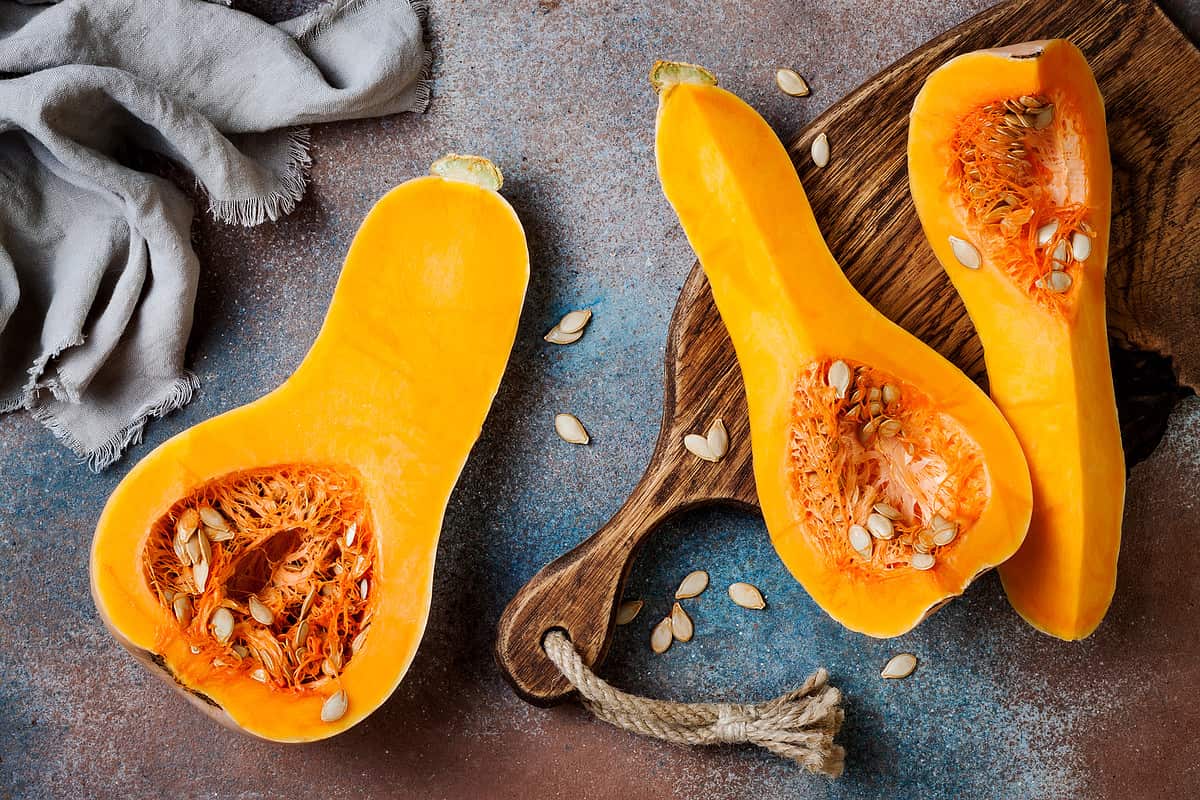
There are a variety of different types of squash. Squash will fall into either the winter squash or summer squash categories. Most squash has a mild flavor and cooks well when roasted or baked.
©iStock.com/sveta_zarzamora
How Nutritious is Squash?
Squash is a very nutritious fruit. It is very high in fiber and can significantly aid digestive health. Many varieties of squash also have vitamins A, B, and C. Additionally, squash is high in potassium.
Squash has two different classifications: summer and winter squash. They are part of the gourd family and of the genus Cucurbita. When you dig deep into the history of squash, you do not have to look hard to find that this fruit is native to the Americas. Long before European settlers came to the New World, squash was harvested by indigenous peoples.
Of the two groups, summer squash grows the most quickly. Harvesting begins before they reach maturation and have a shorter shelf life. On the other hand, winter squash has a long shelf life and is stored for a lengthy time. They are usually much larger than summer squash and are vining fruits. Additionally, winter squash has a more rigid outer shell.
Different Types of Squash: Winter Squash
Winter squash is an annual fruit that grows late and typically comes in bright colors and odd shapes. They also have mature seeds and a tough rind.
- Acorn Squash: It has bright colors and a shape like an acorn. The skin of acorn squash has ridges and can be patchy orange. This type of squash is sweet and has a nutty flavor.
- Banana Squash: Banana squash's name comes from its pale yellow skin and long shape. Although it is usually pale yellow, some squash of this type can be pink or come in stripes. Banana squash can grow to 35 pounds and three feet long. For this reason, you will not find whole banana squash in the store. It is usually already cut.
- Butternut Squash: A very popular type of squash, butternut squash is versatile. The flesh is orange, sweet, and a bit nutty. It is also packed with essential nutrients for everyday living, making it a great addition to any diet.
- Delicata Squash: this squash has green or orange stripes against cream-colored skin. It has other names such as bohemian, peanut, or sweet potato squash.
- Carnival Squash: This squash has a very festive outer appearance, usually having colors like orange, green, and yellow with spots. Carnival squash is small to medium in size and also round. The flavor is sweet, often described as Christmasy. This specific squash is a crossbreed between acorn and sweet dumpling squash.
- Hubbard: Native to the Caribean Islands, this squash can grow large at around one foot and up to 20 pounds. The outer skin is bumpy and can be orange, yellow, or dark green.
- Kabocha: This squash also goes by buttercup squash or a Japanese pumpkin. It is prevalent in Japanese cuisine and is packed with many healthy nutrients like antioxidants.
More Types of Winter Squash
- Pumpkin: A very versatile and mildly sweet squash, it is a staple during the autumn season. It carries antioxidants, Vitamin C, and potassium. Pumpkin is also delicious in desserts, soups, and salads. Another perk is that the seeds are edible when roasted and enjoyed by many!
- Honeynut Squash: This squash is a cross of two different squashes, the butternut and buttercup squash. It has orange to dark tan skin. When fully ripe, the outer skin will be a dark hue of orange. The size is smaller than other squashes, and the flesh is sweet.
- Red Kuri: The skin of the red kuri is relatively thin and looks similar to that of a small pumpkin. However, there are no ridges on a red kuri. This squash will fall into the Hubbard squash group. The shell is hard and firm. Additionally, the flavor of this type of squash is nutty.
- Spaghetti Squash: Spaghetti squash is another popular one with a flesh resembling spaghetti. The strands are spaghetti-like after cooking. The squash itself is large, orange, and has a mild, versatile flavor.
- Turban Squash: This squash gets its name from its appearance. It resembles a turban and can grow to medium to large. The shape is quite unique. Additionally, the skin is bumpy, hard, and multicolored. Turban squash can grow to be around 15 inches and six pounds. The flavor is also sweet and a bit nutty.
- Sweet Dumpling Squash: The skin of this type of squash is tough with a recessed top. It has deep ridges and a strong inside. The color is cream color with green.
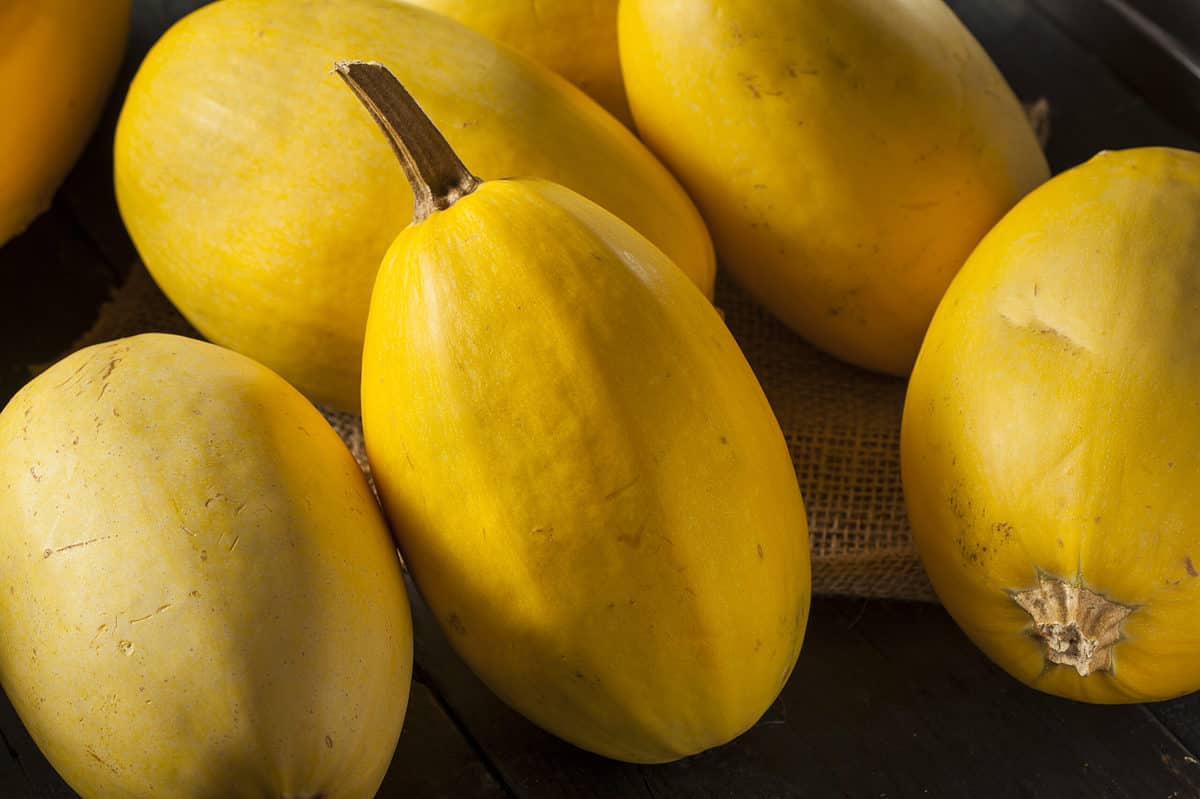
Spaghetti squash is a popular type of winter squash. It has flesh on the inside that resembles spaghetti and is even great as a replacement for noodles in health recipes!
©Brent Hofacker/Shutterstock.com
Different Types of Squash: Summer Squash
Summer squash has a shorter shelf life than winter squash; it usually grows during summertime. The outer skin is not typically hard, and harvesting begins while young. Summer squash seeds are tender.
- Chayote: This type of squash has wrinkly and rough green skin. The pit is large. Additionally, the shape of chayotes is flat and pear-like.
- Crookneck Squash: Crookneck squash looks exactly how it sounds. The appearance has a curve-like stem. The outer skin of this squash is yellow and smooth or bumpy. Additionally, the flavor is sweet.
- Patty Pan Squash: round and flat-looking fruits, this type of squash has a distinct appearance. The edges have grooves, and the fruit itself is small. The color is yellow, white, green, and sometimes multicolored.
- Zucchini: A mild, versatile, and popular green squash, it is an excellent alternative to noodles. The texture of the zucchini is firm.
- Yellow Squash: Yellow squash is long and yellow. It has a mild flavor and cream texture. These characteristics make it versatile.
- Zephyr: A unique squash with a two-tone yellow and lime green appearance. The shape curves and is slender.
- Round Zucchini: This squash looks and tastes like zucchini but is round and small.
- Tromboncino: Also called a zucchetta, this squash is pale green and will fade to beige. The shape is rather odd, and it can grow to be three feet.
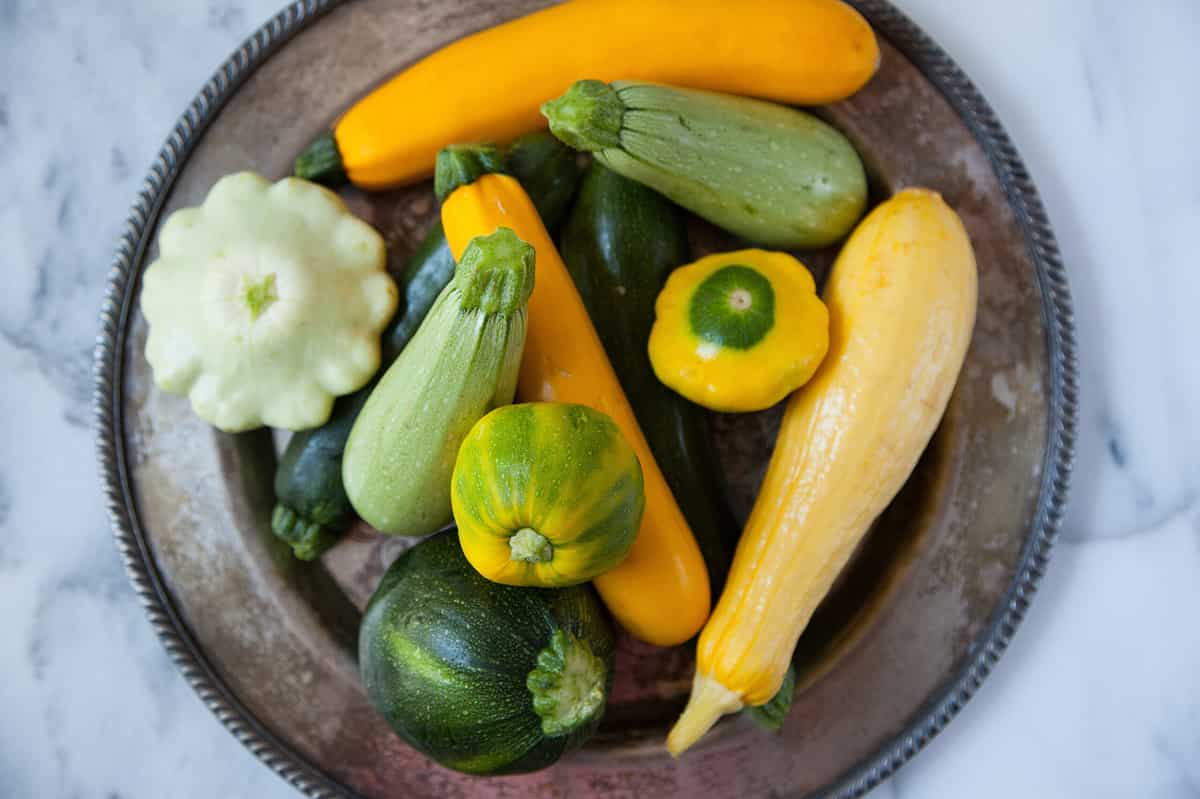
Summer squash comes in a variety of shapes and sizes. They are typically brightly colored as well.
©Ivana Lalicki/Shutterstock.com
Delicious Recipes That Include Squash
Squash is versatile, mild, and delicious! Are you looking for some tasty new dishes? Look no further and try one of these top recipes or methods.
- How To Cook Butternut Squash Perfectly, 3 Ways
- How to Cook Acorn Squash Perfectly, The Two Unique Ways to Do It
- Butternut Squash, Chard, and Spinach Lasagna Recipe
- Fall Vegetable Spaghetti Squash
- Fall Vegetable Butternut Squash
- Stuffed Acorn Squash
- Squash Casserole
- Spaghetti Squash with Tomatoes Recipe
- Spicy Squash Corn Chowder Recipe
- Roasted Chicken and Butternut Squash with Herbed Wine Sauce Recipe
What is Zucchini?
Zucchini is a summer squash that is rich in nutrients and vitamins. Technically, it is a fruit; however, often, people will eat zucchini like a vegetable. This is because zucchini is versatile and mild, which pairs nicely with savory dishes.
Summer squash harvests while immature, and zucchini is no exception. This type of squash can be deep green and even yellow. Zucchini looks similar to cucumber, yet it is easy to tell them apart in the grocery store when you touch them. Zucchini will be softer to the touch.
One reason zucchini is so popular is because it is low in calories, only around 17 calories per zucchini! The low calorie, high nutrients, and versatility means that zucchini is easy to add to any diet.
Unlike winter squash, zucchini is delicious even when raw.
Zucchini is also high in vitamins A and C and Potassium. Additionally, it has magnesium, folate, phosphorus, zinc, calcium, and iron. Aside from all of these benefits, it also has plenty of antioxidants. Antioxidants are essential because they help protect us against free radicals.
Studies have shown that zucchini may also benefit your health in a variety of ways, including:
- Aiding in heart health.
- Good for skin and eye health.
- It may protect against certain cancers.
- It possibly reduces blood sugar levels.
- Good for bone health.
- Aids in thyroid function.
In addition, zucchini has soluble and insoluble fiber. This indicates eating zucchini can help your digestive health. All of these nutrients mean it is an excellent fruit for your health!
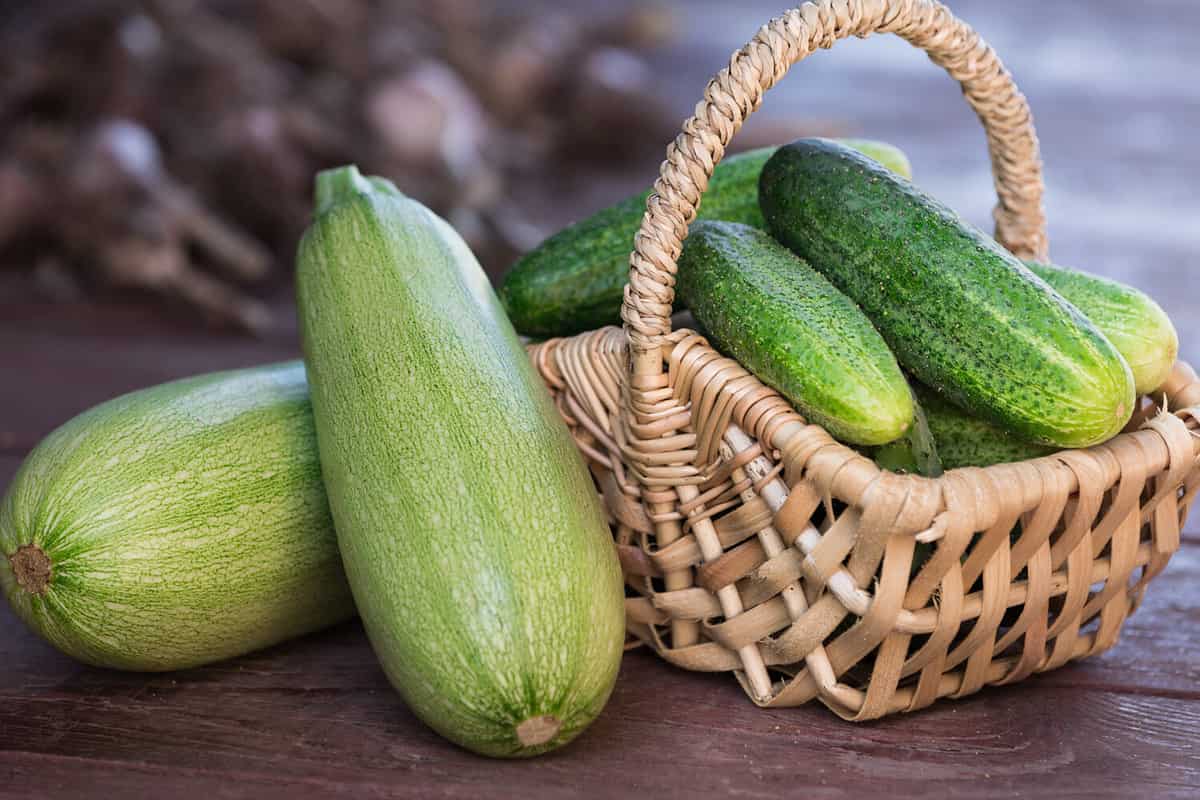
Zucchini is a mild and versatile fruit that cooks much like a vegetable. It is a good noodle replacement in a recipe, added to baked goods, or even roasted for a delicious side dish.
©Fotoksa/Shutterstock.com
Different Recipes That Include Zucchini
Zucchini is versatile and delicious. Try one of these new recipes today!
- 7 Simple and Easy Zucchini Recipes
- Zucchini Lasagna Recipe
- Potato Zucchini Hash Recipe
- Summer Vegetables Zucchini
- Zucchini Cheese Bake Recipe
- Roasted Zucchini With Parmesan
- Roasted Zucchini
- Zucchini Fritters
- Zucchini Muffins
- Chocolate Zucchini Bread
How to Cook Squash or Zucchini
Since zucchini and squash are both very versatile, they can be cooked in a few different ways. Here are the most popular ways to cook them!
Roasting: Roasting squash and zucchini will produce an intense flavor that is either savory or sweet. Most of the time, zucchini and squash can roast with basic ingredients like salt, pepper, and olive oil. However, do not be afraid to experiment with a variety of seasonings and marinades.
Sauteeing: Pan-frying or sauteeing squash or zucchini is a faster way to get dinner on the table. The flavor is still delicious, but in a shorter amount of time!
Air-Frying: Air-frying is becoming an increasingly popular method of cooking. Most zucchini and squash can be air-fried. All you have to do is find a recipe you love.
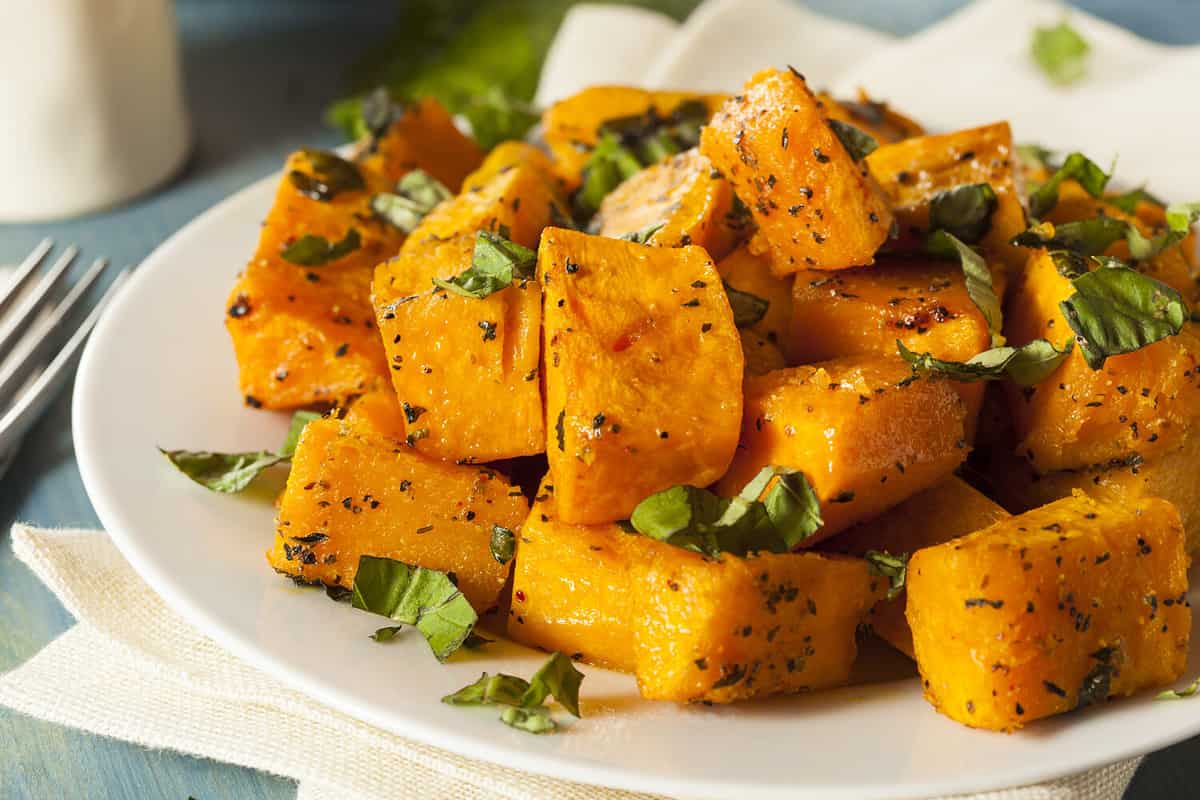
There are many quick and easy ways to cook squash and zucchini. With the versatility and nutrients packed in every bite, how could you not enjoy this delicious fruit?
©Brent Hofacker/Shutterstock.com
Recap: Differences Between Zucchini and Squash
Now that we have explored the many types of squash and discussed what squash and zucchini are let's look again at the differences.
First, squash is an all-encompassing term. It includes several different types of squash. The two types of squash are winter and summer. Zucchini falls into the summer squash category.
Zucchini has one or two specific shapes. Typically, when someone thinks of zucchini, they perceive the oblong shape. Additionally, the most popular version of zucchini is green. However, zucchini can also come in a small round shape, and there are yellow zucchini. Zucchini is typically smooth on the outer surface, and it is soft.
Squash comes in a variety of different colors and shapes. Some shapes are round, others are long. Some squash grow to be quite large. Additionally, squash can have multicolors and spots. Most squash have some green, white, yellow, and orange variation. Sometimes, squash is smooth; other times, it has ridges and dips. Also, the outer skin can be hard or soft depending on the type of squash, winter or summer.
The flavor profile of squash will vary. Many times, they are sweet and nutty. Most of the time, squash has a mild flavor, much like zucchini. Zucchini is sometimes bitter yet has a savory flavor profile, making it versatile.
All squash is nutrient-rich. However, zucchini is low in calories and carbohydrates, making it an excellent addition to a low-carb diet.
Regardless of the type of squash you prefer, one thing is sure. There are many choices, whether you love your squash sweet and versatile like pumpkin or low carb and savory like zucchini. Your personal preference is key to finding the right fit for yourself!
The image featured at the top of this post is ©David Kay/Shutterstock.com
